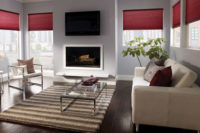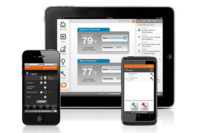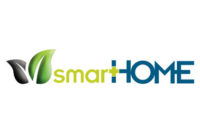
Soffit lighting set to varying intensities creates a three-dimensional feel, showcasing the architectural features of this distinctive log home.

The “SmartHome: Green + Wired” exhibit, which ran from March 2008 to January 2009, at the Museum of Science and Industry in Chicago showed homeowners how currently available technology can be used to save energy.
Depending on project goals, homeowner needs and the nature of a home’s construction, every lighting control installation presents a unique set of challenges. While much of the design and installation process demands technical proficiency, adding a touch of creative thinking can result in both innovative solutions to technical obstacles and dramatic lighting effects. Tackling issues of increased energy efficiency, enhanced aesthetic beauty and expanded system capability, these integrators discovered some unique approaches to meeting their customers’ needs.
A Model of Efficiency
Last March, the Doherty Design Group, Indianapolis, received a call from Lutron Electronics, Coopersburg, Pa., with a request for help on a very special residential installation: a model home designed to show homeowners how they could go green in their own homes using current technologies. The result was the “Smart Home: Green + Wired” exhibit, on display at the Museum of Science and Industry in Chicago from March 2007 through January 4, 2009. The model home featured energy-saving fixtures, including exterior sconces outfitted with compact fluorescent bulbs and widespread use of LEDs for downlighting and under cabinet lighting. The home’s LifeWare automation system allows users to control the system and monitor a home’s energy use.Although the energy-efficient lighting and other green technologies in the home had been planned from the beginning, it was not until after the home had been built that the decision was made to include remote lighting controls. By the time Doherty Design had been contacted for the job, fixtures using LEDs and compact fluorescent bulbs had already been installed. According to Charlie Derk, systems engineer for Doherty, the greatest challenge was to match the control technologies to the individual fixtures. Derk’s team installed controls for the entire house using the Lutron HomeWorks system, which provided the options necessary to meet the needs of the project. For some of the fixtures, standard dimmers were sufficient; others required special adaptations, such as interfaces between the dimmers and the low-wattage LED fixtures. And, of course, for the compact fluorescent bulbs, there was no choice but standard switching.
Derk said that, ideally, coordination of the fixtures and controls should be included in the initial lighting design before installation begins. However, this project was actually completed much like a residential retrofit installation.
Brilliant Accents
The Doherty Design Group’s work on the “Smart Home: Green + Wired” exhibit showcased the energy-saving possibilities of lighting, but that is just the beginning of lighting’s potential. In another project, Craig Kovacs, president of Home Technology Solutions, tapped into lighting’s aesthetic capability to showcase the inherent beauty of a home’s architecture.Though more common in other parts of the country, a log cabin style home is still a pretty unusual sight in Lehigh Valley, Pa. Handcrafted from materials imported from a region northwest of Vancouver, British Columbia, Canada, this distinctive, single family home also includes a roomy in-law suite. With 5000 square feet of deck and patio space and 30-foot vaulted ceilings, the home is as spacious and comfortable as a resort lodge.
For Kovacs, the 12,000-square-foot home presented some unique challenges for lighting integration. The project goal was to design a wireless system that would not only meet the requirements for everyday use and security needs, but also showcase the architectural features of the home. Kovacs was apprehensive about the size of the area to be covered and the number of devices needed to make a wireless system work. To meet all of the project objectives, several areas would require multiple dimmers and high electrical loads.
To accommodate the high power loads, he installed large (1,500-2,000 watts) power boosters. Even with those in place, Kovacs was still concerned about using a wireless system on a project of this magnitude, knowing that older technologies required installation of multiple repeaters to support a system on this scale. He found the CentraLite JetStream wireless system was ideal for this type of installation because each device can transmit directly to any other device in the network, eliminating the need for additional controls. He was also concerned about the responsiveness of a system so large. As it turned out, his fears were unfounded; the wireless mesh technology handled the system demands superbly. “The technology is smart enough to find the most direct route, so the effect is instantaneous,” said Kovacs.
The end result was not only instantaneous, but incredible. In addition to the exterior lighting used for safety and security purposes, 115 recessed soffit lights were installed to accent the architectural features of this distinctive log home. Kovacs also programmed various exterior lighting scenes to be activated at sunset. Using varied intensities for the accent lighting on different features, he was able to give the display a three-dimensional effect. After midnight, the exterior light intensities are dimmed until someone pulls into the driveway and the motion sensors return them to full brightness.
Kovacs says he likes to bring an artist’s creativity to all of his lighting projects, even without the decorative lighting. “When the house is lit up at night, it is breathtaking,” he said.
Redefining the Limits
Creative approaches to lighting controls can be employed to not only enhance a home’s beauty, but its security as well. When homeowner Randy Meridith decided to renovate his house in St. Charles, Ill., setting up the lighting and security system for the 6000 square foot Country French-style home was no small undertaking.“Technology was a huge factor in the renovation decisions,” said Gerry Koser, president of TES Inc., Barrington, Ill.
Because Meridith divides his time between residences in Illinois, Colorado, and California, he had many needs to ensure the security of his home. Koser said that the integration of security and lighting was essential. Equally important was the remote access software from the camera surveillance system. The size of the home was also an issue; integrating the existing lighting in the older part of the home with the newly renovated portion of the home would be a significant challenge. In fact, so many circuits had to be added in the home that an additional 400 amp electrical panel was installed. Koser chose CentraLite’s wireless JetStream Lighting Control System for its scalability and flexibility. Not only could the JetStream system support all of the interior lights and perimeter lights currently installed in the home, but its modular design allowed plenty of room for future expansion.
The TES team’s first step was to expand the monitored security system by hardwiring locations of the home where security protection was currently lacking. The lighting control system was coordinated with the high-end security cameras by Speco Technologies, Amityville, N.Y.
Meridith wanted the lighting design to give the home a lived in look even when he was away. Using an astronomical clock by JetStream, the TES team programmed the system to light up common areas of the home, incorporating up to 50 timed scenic events, which vary according to the time of day and season.
The Digital Watchdog DW-MAX-II 8 camera monitoring software, coordinated with the Honeywell security system and JetStream lighting controls, gives Meridith extensive monitoring capabilities both within the home and via remote access. If there is a disturbance while Meridith is at home, he can immediately turn on all the inside and outside lights using any of the one-touch table top keypad controls located throughout the house. He can see in real time what is going on around his property by turning on any of his flat screen TVs.
If a security breach occurs while Meridith is away from his home, the system will page him immediately. The remote monitoring software allows him to monitor the video in real time. To keep up with Meridith’s busy travel schedule, Koser had to design a system that could record up to one month at a time, which meant that the DVR needed a full terabyte of data.
Conquering everything from incompatibility to accessibility, these integrators have discovered how a little ingenuity uncovers solutions to surmount the obstacles of current projects. These new approaches can also provide comfort and convenience for future customers.
SIDEBAR: Rest Assured
Greg White and his family were looking for a robust home automation system with options that met the needs of their growing, young family. The layout of the two-story, brick Colonial home in Charlotte, N.C. presented some unique challenges for parents with a kindergartener and two toddlers. With two separate staircases separating the children’s second floor bedrooms from the master bedroom on the main floor, White wanted to be sure that the kids would be able find their way to mom and dad if they woke up in the middle of the night.White contacted Mark DiPietro of Custom Home Integrations, Mooresville, N.C., for help. DiPetro configured a Honeywell IS-2535 motion detector at the end of the upstairs hallway to act as a trigger. When a child leaves her room, the system illuminates a pathway from the hall to the master bedroom, so the girls can find their way and don’t risk falling on the stairs.
White later added a second sensor in his 5-year-old daughter’s bathroom. When triggered, the sensor activates the bathroom lights to come on at 25 percent intensity and stay on for two minutes, allowing his daughter to find her way in the bathroom and back to bed, without being jolted awake by brightness of full-intensity lighting.
SIDEBAR: Unique Solutions for Special Needs
Mike Rutland of Systems by Design, Spicewood, Texas, installs systems for clients with physical disabilities about once a year. The unique challenges he faces in these projects provide him with ideas to improve his designs for all installations. In the past, he designed a lighting system for a client with cerebral palsy. Given the customer’s limited mobility, special consideration had to be given to the lighting controls in order to meet the customer’s needs. “When he did or said certain things, the lights would go on,” said Rutland. Using HAL 2000 voice-activated software and a blow tube connected to his Macintosh computer, the customer was thrilled to be able to turn on the lights for himself for the first time in his life. Rutland also installed multiple motion detectors, so that whenever the customer’s wheelchair activated them, the path in front of him would illuminate.Rutland also recently designed a lighting system for a woman who was hearing impaired. When her children get up, a motion detector activates a light next to the woman’s bed, causing it to flash and signaling her to go to them. For the same project, he used the doorbell as a trigger to flash the lights on the back porch. While this was a necessity for the customer with limited hearing, Rutland now uses the same approach for hearing customers who may not hear the doorbell when working or relaxing in the backyard.





